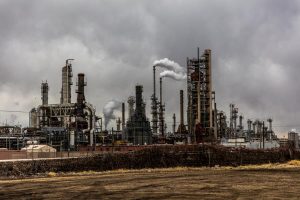 What is natural gas? Natural gas is a kind of fossil fuel, a naturally occurring mixture of hydrocarbon gas. Another term for this is fossil gas or sometimes abbreviated as NG. It consists of methane and higher alkanes and sometimes has a small percentage of hydrogen sulfide, nitrogen, helium, or carbon dioxide. This gas is a production of plants’ and animals’ decomposing layers exposed in intense heat and pressure under the surface of the Earth.
What is natural gas? Natural gas is a kind of fossil fuel, a naturally occurring mixture of hydrocarbon gas. Another term for this is fossil gas or sometimes abbreviated as NG. It consists of methane and higher alkanes and sometimes has a small percentage of hydrogen sulfide, nitrogen, helium, or carbon dioxide. This gas is a production of plants’ and animals’ decomposing layers exposed in intense heat and pressure under the surface of the Earth.
Natural gas has developed into a critical resource for worldwide energy needs. It is exuberant, versatile, and clean-burning. Its purpose gained many industries that are in parallel to power generation, industrial applications, buildings, and transportations.
Natural gas, facilitated by investments from different sectors, is traded globally. The future demand for natural gas supply is possible to grow, where it can replace coal power and fill power gaps made by intermittent renewable energy sources. Here is a list to have a better understanding of the significant uses of natural gas.
Use as Electric Power Generation
The natural gas is a primary source of electric power generation through gas turbines, steam turbines, and cogeneration. Natural gas is also associated with renewable energy sources such as solar and wind, and sometimes functioning together with hydroelectric plants.
Compared with coal, natural gas burns more cleanly. Since burning natural gas produces both carbon dioxide and water, it gives lesser carbon dioxide per unit energy released than coal – that produces mostly carbon dioxide. Natural gas yields forty-five percent less carbon dioxide per kilowatt-hour than burning coal.
Compared with petroleum, burning natural gas produces about thirty percent less carbon dioxide than burning oil, in connection to transportation. In the same way, burning natural gas releases lesser quantities of sulfur dioxide, particulates, nitrogen oxides, and mercury when related to coal and oil.
Use for Manufacturing Process
Natural gas is present in a wide range of manufacturing processes, for it both stands as raw material and a source of heat.
It is an ingredient to fertilizer, antifreeze, pharmaceuticals, plastics, and fabrics. It is also used to produce chemicals like ammonia, butane, ethane, propane, methanol, and acetic acid.
Not only that, it works as a heat source like manufacturing LPG and CNG that people use for cooking. Way back, natural gas industries use metal seat ball valves in LPG and CNG. However, soft seat high-performance butterfly valves replaced them in the market because they are cheaper, lighter, and supports tight shut-off.
Furthermore, natural gas has a significant role in manufacturing steel, glass, cement, ceramics, bricks, paper, food products, and a lot more of commodities. In the same manner, it is used for incineration in many facilities.
Household and Commercial Use
Natural gas is essential for domestic and commercial use when it comes to space heating, water heating, and sometimes for air conditioning. It is also required to use the oven, stove, clothes dryers, lighting fixtures, and central heating through pipelines in much-developed countries.
Use in Transportation
Natural gas has the potential as an alternative use for fuel since it is cleaner and cheaper than petrol. The primary barriers to this are the short-range of vehicles, limited refueling options, and slow refueling times. Nevertheless, over the past few years, refueling station prices only dropped just a few amounts. These stations can be replaced in the residence where vehicles can refuel between trips or overnight.
Natural gas is an excellent use for aircraft too. The two advantages of liquid methane as a fuel for jet engine is that first, it has more specific energy than the basic kerosene fusions do. Second, its low temperature can help cool the air, acting as an intercooler.
As an environmental and economic advantage, natural gas vehicles emit sixty to ninety percent less smog-producing pollutants and thirty-forty percent less greenhouse gas emissions. It also costs less per mile to operate a natural gas vehicle compared to a gasoline or diesel vehicle.
Use as a Fertilizer
The natural gas is present in the production of ammonia, an element that supports fertilizer production.
Use to Produce Hydrogen
Natural gas, as hydrogen reformer, can produce hydrogen. Hydrogen has a lot of applications. It is the main raw material in the chemical industry, a hydrogenating agent, a fuel source for hydrogen vehicles, and important goods for petroleum refineries.
Conclusion
Natural gas is indeed an all-around resource that will take over the global industries. Since it is the most economical and clean to use among the three fossil fuels, this natural resource has become an essential part of the energy mix; and will remain so because of its accessible resources, low carbon track, sizeable, and versatility.
Although complex infrastructure is needed to get natural gas to end-users, global trade is increasing, and the share of energy from natural gas is expected to rise in the future. Because of its indeed potential, experts even call it “The Future of Energy,” and will gain substantial market share from coal due to its capability to reduce air pollution compared to the latter. Ten to twenty years from now expect natural gas will turn the table in the global market.
 TechManik Best Cheap Android Phones and Tablets | Android Apps
TechManik Best Cheap Android Phones and Tablets | Android Apps 

